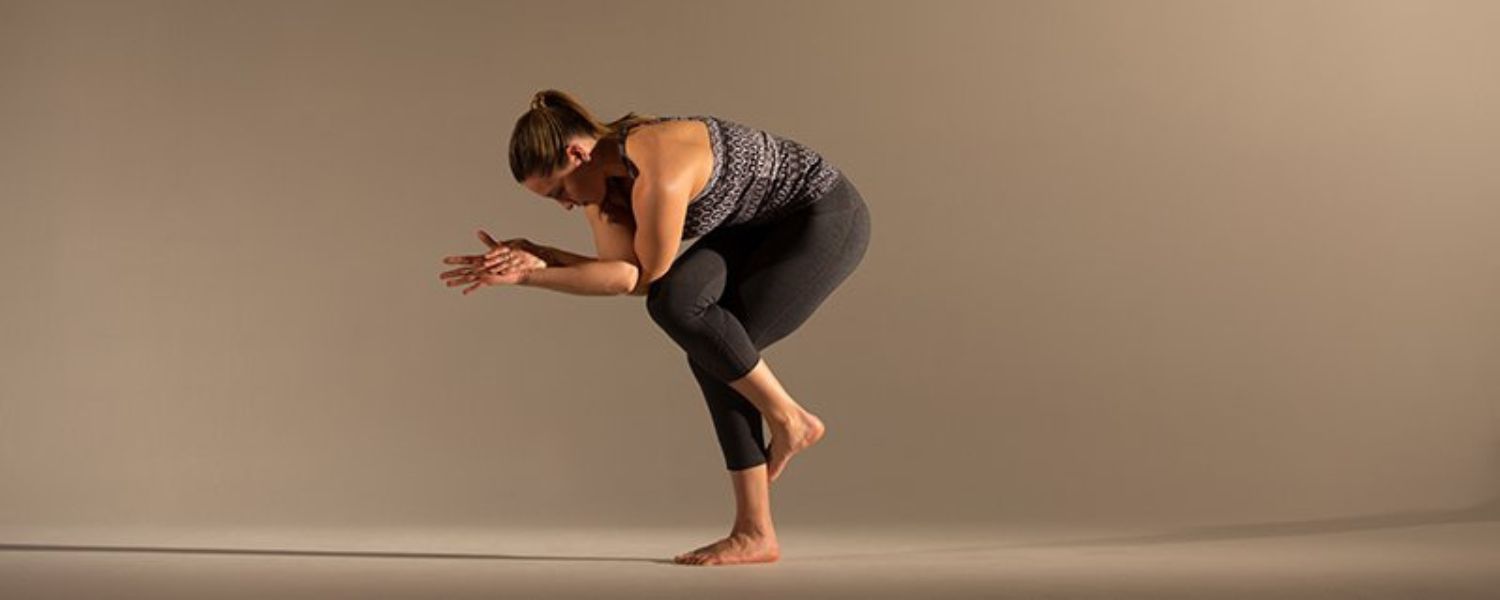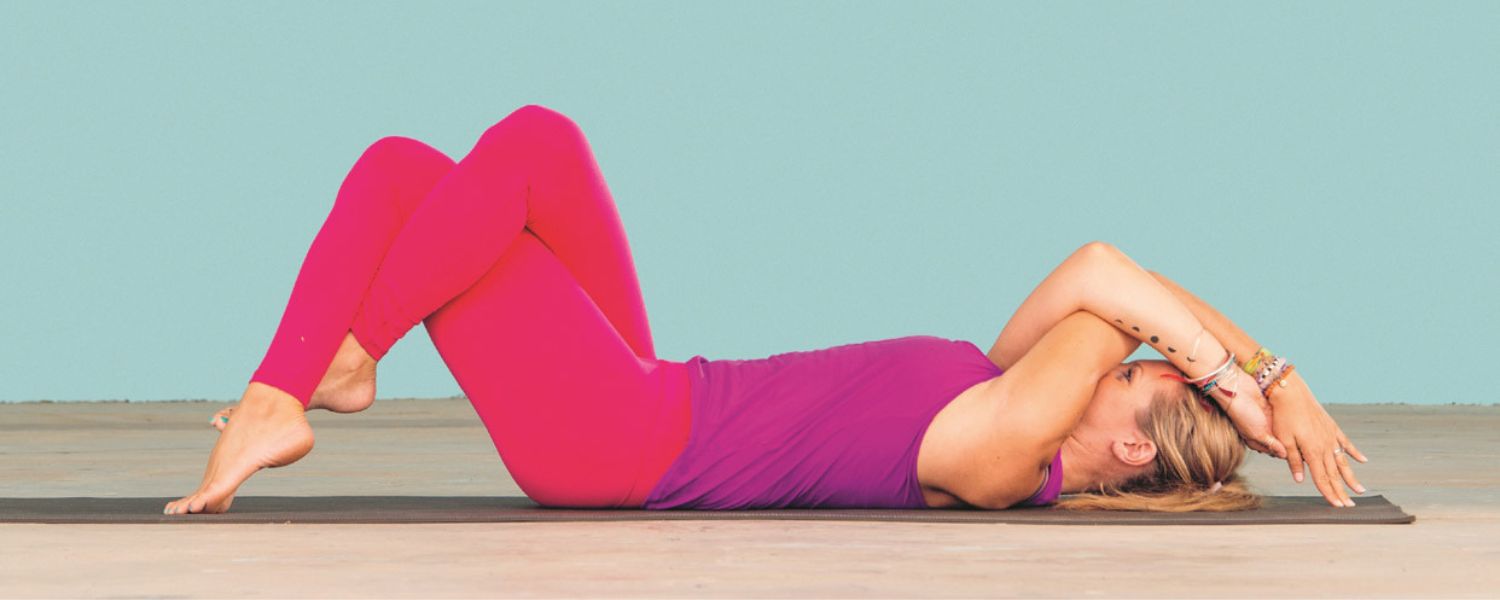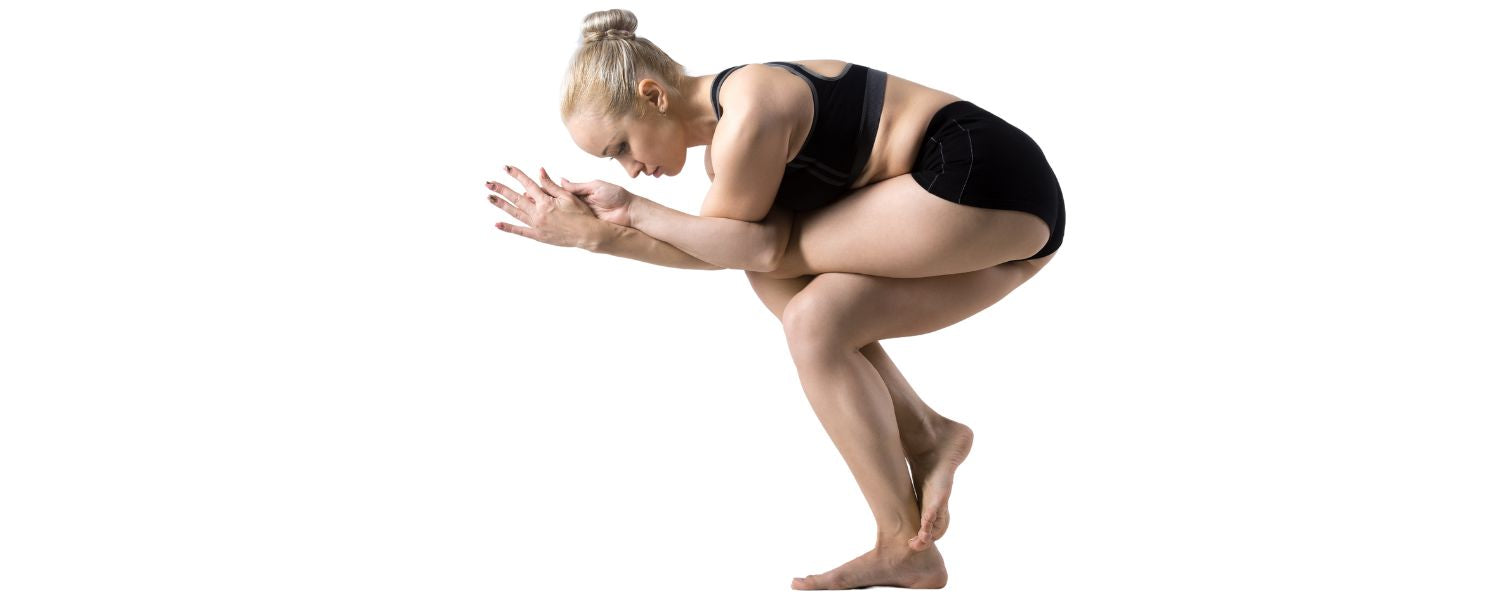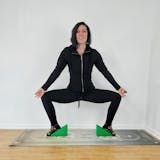Eagle Pose, known as Garudasana (gah-rue-DAHS-anna) in Sanskrit, is a fundamental posture in yoga that offers many benefits for the body and mind.
Its graceful and powerful nature embodies the strength and agility of the eagle, inspiring practitioners to cultivate balance, stability, and focus in their practice.
Pose Type
Yoga categorizes poses by focus and difficulty. Standing balance poses, such as Eagle Pose (Garudasana), demand strength, flexibility, and mental concentration for stability and inner calm.
Target Area
Garudasana, the Eagle Pose, intricately engages various muscle groups including legs, hips, shoulders, and upper back. It fosters strength, flexibility, and endurance while promoting stability, posture, and mobility.
Beginner Tips
Here are some beginner tips to help you approach Eagle Pose (Garudasana) with confidence and ease:
1. Start with a Solid Foundation
Stand in Mountain Pose (Tadasana) with your feet hip-width apart. This foundational posture helps establish stability and alignment before moving into the Eagle Pose.
2. Warm-Up Properly
Before practicing Eagle Pose, it's beneficial to warm up your body with gentle stretches and movements. Focus on the hips, shoulders, and ankles to ensure they loosen up adequately.
3. Use Props for Support
If you're struggling with balance or flexibility, don't hesitate to use props such as a wall or a chair for support. Placing a block under your bottom foot in the seated version of Eagle Pose can also help you maintain stability as you build strength and flexibility.
4. Focus on Alignment
Pay close attention to the alignment of your body as you move into Eagle Pose. Keep your knees and elbows in line, and ensure your wrists align with your shoulders. Maintaining proper alignment helps prevent injury and allows you to experience the full benefits of the pose.
5. Listen to Your Body
Honor your body's limitations and avoid pushing yourself too hard, especially if you're new to yoga or have any existing injuries. It's okay to modify the pose or take breaks as needed. Keep in mind that yoga is a journey, and achieving progress requires patience and dedication over time.
6. Stay Present and Breathe
As you move into Eagle Pose, focus on your breath and stay present. Use deep, steady breaths to help you relax and find stability in the pose. Avoid holding your breath, increasing tension, and making the pose more challenging.
7. Be Patient and Persistent
Mastering Eagle Pose takes time and practice, like any yoga posture. Be patient with yourself and celebrate your progress, no matter how small. Stay consistent with your practice, and you'll gradually build strength, flexibility, and confidence in this empowering pose.
How to Do Eagle Pose in Yoga
1. Start in Mountain Pose (Tadasana)
Start by standing upright at the front of your mat, ensuring your feet are hip-width apart and your arms hang naturally by your sides. Ground through your feet, engage your thigh muscles and lengthen your spine.
2. Shift your Weight
Shift your weight onto the left foot, grounding it securely into the floor. Activate your core muscles to support your stability as you hold the pose.
3. Cross your Right Thigh Over the Left
Lift your right leg and cross it over your left thigh. Aim to hook your right foot behind your left calf if possible. If you're unable to hook your foot, simply cross your legs as comfortably as you can.
4. Cross your Arms
Stretch your arms out to the sides, keeping them level with your shoulders and parallel to the floor. Cross your right under your left arm, bringing your palms together if possible. If your palms don't touch, press the backs of your hands together instead.
5. Wrap Your Arms
Bend your elbows and wrap your right forearm around your left forearm, bringing your palms together in front of your face. Your elbows should be stacked directly over your wrists.
6. Sink into the Pose
Initiate a gentle bend in your knees, gradually lowering your hips as if you were settling into an invisible chair behind you. Keep your spine long and chest lifted, and maintain a steady gaze forward to help with balance.
7. Press the Thighs Together
As you sink deeper into the pose, actively press your right thigh against your left thigh and your right foot against your left calf. This engagement helps to deepen the stretch and build strength in the legs.
8. Hold and Breathe
Hold Eagle Pose for 5-10 breaths, maintaining steady breathing throughout. Focus on finding stability and balance in the pose while keeping the mind calm and focused.
9. Release and Repeat
Slowly unwind your arms and legs and return to Mountain Pose to release the pose. Take a moment to observe any sensations in your body before mirroring the pose on the other side, crossing your left thigh over your right and wrapping your left arm under your right.
Practice Eagle Pose mindfully, paying attention to your body's cues and respecting its limitations. With consistent practice, you'll gradually build strength, flexibility, and physical and mental balance in this empowering yoga posture.
Benefits of Eagle Pose
Eagle Pose (Garudasana) offers various physical, mental, and emotional benefits for practitioners of all levels. Here are some of the key benefits of incorporating Eagle Pose into your yoga practice:
1. Improved Balance
Eagle Pose requires concentration and focus to maintain balance while balancing on one leg and wrapping the opposite leg and arms. Regular practice can help improve proprioception and balance skills, benefiting various aspects of daily life.
2. Strengthened Muscles
This pose engages multiple muscle groups, including the quadriceps, hamstrings, glutes, calves, shoulders, and upper back. Holding the pose strengthens these muscles, promoting overall stability, strength, and endurance.
3. Enhanced Flexibility
Eagle Pose stretches the muscles and joints of the legs, hips, shoulders, and upper back, helping to improve flexibility and mobility in these areas. Regular practice can help reduce stiffness and increase the range of motion.
4. Improved Concentration
The focus required to maintain balance and coordination in Eagle Pose helps quiet the mind and improve concentration. Practicing mindfulness during this pose can enhance mental clarity and focus on and off the mat.
5. Relief from Tension
Eagle Pose involves wrapping the arms and legs, which creates a gentle compression and release effect that helps alleviate tension and stiffness in the shoulders, upper back, hips, and thighs. This can relieve tightness and discomfort caused by prolonged sitting or standing.
6. Stimulated Circulation
The twisting action in Eagle Pose helps stimulate blood flow and lymphatic drainage, promoting circulation throughout the body. This can help oxygenate the blood, flush out toxins, and improve overall energy levels and vitality.
7. Calming Effect on the Mind
Eagle Pose is known for its grounding and calming effects on the nervous system. The focused breathing and concentration required in this pose can help reduce stress, anxiety, and mental fatigue, leaving you feeling more relaxed and centered.
8. Improved Posture
Practicing Eagle Pose enhances posture by strengthening the muscles that uphold the spine and shoulders. By aligning the body properly in this pose, you can develop better posture habits that carry over into everyday activities.
9. Energetic Benefits
In yoga philosophy, Eagle Pose is believed to stimulate the flow of prana (life force energy) throughout the body, particularly in the nadis (energy channels) associated with the legs and arms. This can help balance the body's energy system and promote a sense of vitality and well-being. Incorporating the Yoga handstand into your practice can further amplify these energetic benefits.
Common Mistakes
To optimize the advantages of Eagle Pose and steer clear of injuries, steer clear of these common mistakes:
1. Collapsing the Standing Knee
One common mistake is allowing the standing knee to collapse inward toward the body's midline. This misalignment can put excessive strain on the knee joint and compromise stability in the pose. Instead, focus on keeping the standing knee aligned with the toes of the foot and pointing straight ahead.
2. Rounding the Upper Back
Another common error is rounding the upper back and shoulders forward, especially when attempting to wrap the arms tightly around each other. This can compress the chest and restrict breathing, making maintaining proper alignment and balance difficult. Instead, focus on keeping the chest open and the shoulder blades drawing down and back to maintain a long, neutral spine.
3. Gripping the Toes Too Tightly
Some practitioners may unconsciously grip their toes or press them too firmly against the calf of the standing leg in an attempt to maintain balance. While engaging the muscles of the feet and legs is essential, gripping the toes excessively can create tension and strain in the foot and ankle. Instead, focus on pressing evenly through the entire foot, balancing stability and ease.
4. Hunching the Shoulders
It's common for practitioners to hunch their shoulders up toward the ears, especially when attempting to wrap their arms tightly around each other. This create tension in the neck and shoulders and compromise the integrity of the pose. Instead, focus on keeping the shoulders relaxed and drawing them away from the ears, allowing the chest to remain open and spacious.
5. Holding the Breath
Resist the urge to hold your breath or breathe shallowly, especially in challenging poses like Eagle Pose or Thread the Needle Yoga Pose. This restricts body tension, making it harder to find stability and ease. Focus on maintaining smooth, steady breaths to deepen the pose and calm the mind.
Modifications & Variations
Modifications and variations can help adapt Eagle Pose (Garudasana) to suit different body types, levels of flexibility, and specific needs. Here are some modifications and variations to consider:
1. Seated Eagle Pose
If balancing on one leg is challenging or you have mobility issues, you can practice a seated version of Eagle Pose. Find a comfortable seated position, either on the floor or a chair, cross one leg over the other, and wrap the opposite arm under the other, as you would in the standing version.
This seated variation provides similar benefits for the hips, shoulders, and upper back without requiring as much strength or balance.
2. Broken Eagle Pose
If you have limited shoulder mobility or find it difficult to wrap your arms tightly around each other, you can practice a modified version known as Broken Eagle Pose.
Instead of wrapping the arms completely, cross the elbows and bring the backs of the hands together, or simply bring the palms together in front of the face. This variation still provides a stretch for the shoulders and upper back while being more accessible for those with tight shoulders or a limited range of motion.
3. Using Prop
Props can be helpful for providing support and stability in Eagle Pose, especially for beginners or those with limited flexibility. Consider using a wall or a chair for balance support, or place a yoga block under your bottom foot in the seated version to help lift and support the hips.
Props can help make the pose more accessible while still providing the benefits of the posture.
4. Half Eagle Pose
Another variation to consider is Half Eagle Pose, where you perform the leg crossing but not the arm wrapping. Begin by standing upright, cross one leg over the other, and focus on pressing the thighs together while keeping the arms extended out to the sides.
This variation allows you to work on balance and stability without the added complexity of wrapping the arms.
5. Advanced Variations
For those looking to deepen their practice, there are advanced variations of Eagle Pose to explore. Flying Eagle Pose involves extending the arms and legs straight out to the sides while balancing on one leg, resembling the wingspan of an eagle in flight.
This variation demands strong core engagement and balance skills and should be approached with caution and under the supervision of a seasoned instructor, particularly for practitioners focusing on core strengthening yoga poses.
Regardless of which modification or variation you choose, listen to your body and practice with awareness and mindfulness. Modify as needed to ensure safety and comfort, and gradually explore more challenging variations as your practice evolves.
Remember that yoga is a personal journey, and there is no one-size-fits-all approach. Find what works best for you and enjoy the journey of exploration and self-discovery on the mat.
Tips
1. Focus on Alignment
Pay attention to the alignment of your body in Eagle Pose. Keep your knees and elbows in line with each other, and ensure that your wrists are aligned with your shoulders. Maintaining proper alignment not only prevents injury but also allows you to experience the full benefits of the pose.
2. Keep a Steady Gaze
Fix your gaze on a point in front of you, known as a drishti, to help you maintain balance and focus in Eagle Pose. A steady gaze can help calm the mind and prevent dizziness or disorientation.
3. Use Your Breath
Use deep, steady breaths to help you relax and find ease in Eagle Pose. Focus on lengthening the inhales and exhales, permitting the breath to lead you deeper into the pose and release any tension or resistance in the body.
4.Start Slow and Build Stability
If you're new to Eagle Pose or working on improving your balance, start slow and focus on building stability before attempting more advanced variations. Use props or modify the pose as needed to support your practice and gradually work your way up to more challenging variations.
5. Listen to Your Body
Remember how your body feels in Eagle Pose and honor its limitations. If you experience discomfort or pain, remove or modify the pose as needed. Keep in mind that yoga is a practice of self-awareness and self-care, so listen to your body and practice with compassion.
6. Practice Regularly
Like any yoga posture, consistency is key to mastering Eagle Pose. Integrate Eagle Pose into your routine yoga sessions and explore variations to keep your practice fresh and engaging. With time and dedication, you'll gradually build strength, flexibility, and balance in this empowering pose.
7. Stay Present
As you practice Eagle Pose, stay in the moment and cultivate mindfulness. Release any distractions or concerns, and concentrate on the sensations within your body, the flow of your breath, and the clarity of your mind. Allow yourself to fully immerse in the pose experience and embrace the journey of self-discovery on the mat.
Why We Love This Pose
Eagle Pose is a beautiful embodiment of grace, strength, and focus. It presents challenges to both the body and mind, inviting practitioners to cultivate balance and stability on and off the mat. Its symbolism of the majestic eagle inspires us to soar to new heights physically and spiritually.
Conclusion
Incorporating Eagle Pose into your yoga practice can bring about profound physical and mental transformation.
By finding stability and focus in this powerful posture, you can cultivate strength, balance, and resilience that extend far beyond the mat.
So spread your wings, embrace the challenge, and let the spirit of the eagle lead you toward enhanced well-being and self-discovery.










